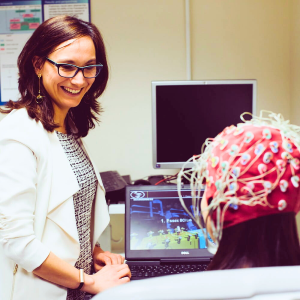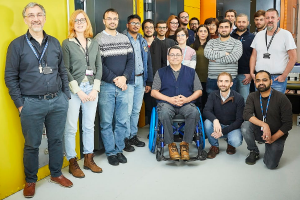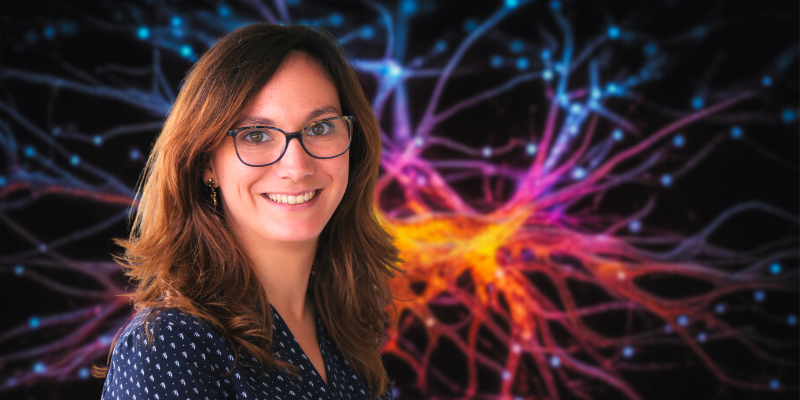Dr Ana Matran-Fernandez is a prominent researcher and lecturer in neural engineering and artificial intelligence in the Department of Computer Science and Electronic Engineering (CSEE) at the University of Essex, specialising in the intersection of technology and society. As well as lecturing, Ana’s role involves transferring knowledge from the academic to the real world, collaborating with companies to help them use state-of-the-art artificial intelligence and machine learning techniques to foster growth and create positive impact. Her research interests are in brain-computer interfaces, biomedical signal processing, and machine learning applied to biomedical signals.

“The potential to improve the quality of life for individuals with neurological conditions is massive, but it’s not straightforward in the short term.”
Discovering brain-computer interfaces, my true passion
I started my academic career in Spain, doing an MEng in Telecommunications Engineering at the Universidad de Valladolid, which is where I’m originally from. I always knew I wanted to study further than one degree, so when I finished, I moved to the UK to do an MSc in Biomedical Engineering.
Both during my MEng and MSc degrees I did my final year projects/dissertations on analysis and classification of biomedical signals, so electroencephalograms (EEGs) for epilepsy prediction in my MEng, and then respiratory and electrocardiograms (ECGs) in my MSc for ambulatory monitoring systems in hospitals. (Ambulatory monitors are devices that record the electrical activity in the heart.)
It was during my MSc I first heard about brain-computer interfaces (BCIs), direct communication pathways between the brain’s electrical activity and an external device, most commonly a computer or robotic limb. I wasn’t sure I wanted to do a PhD at that point, but I had been told that if I did it should be on something I was truly passionate about. After hearing about BCIs I decided that this was something I wanted to pursue, so I did my PhD in collaborative BCIs in the University of Essex.
Afterwards, I followed up with a post-doctoral researcher position in a Horizon 2020 (an EU funding programme) project aimed at controlling prosthetic hands by trans-radial (below the elbow) amputees and eventually became a lecturer after a secondment in the Institute for Analytics and Data Science at the University of Essex.
About our Brain-Computer Interfaces and Neural Engineering Research Group
The Brain-Computer Interfaces and Neural Engineering (BCI-NE) group is the largest in the UK for non-invasive BCIs.
There are two (or maybe three) main streams of work:
- One devoted to working with patients, with academics working on neurorehabilitation (e.g., after a person has suffered a stroke) and restoring communication (for people with severe disabilities);
- Another is on human augmentation, where the BCIs are used to enhance human capabilities (e.g., by bypassing the usual peripheral pathways, for faster decision-making), which is where I think most of the collaborative BCI work is currently being done;
- and a last one where the aim is not to use the BCI to actively control something, but geared towards understanding more about how the brain works (I wouldn’t say this is neuroscience per se; there’s a field called “neuroergonomics” that is perhaps a better term for this third strand).
In my role as a lecturer in neural engineering and artificial intelligence, I have a varied schedule depending on the time of the year. There are times when most of my schedule is devoted to teaching (I teach an MSc module I love, called “Data Science and Decision Making”) and times when I am much more flexible to conduct research on the brain and supervise students working on their dissertations.
During my research time, I work on creating new hypotheses to test and come up with experiments to test them. I (usually with the help of students) collect EEG data from experiments and normally spend most of the time analysing it. I also collaborate with other colleagues and we work together on datasets so that we can publish our results.
Improving the quality of life for individuals with neurological conditions

We also have a recent paper in which we look at EEG for diagnosing disorders of consciousness in comatose patients, and some of my colleagues work on pain detection from the EEG, which has great potential for unconscious people who can’t convey this pain to their carers.
Faster and more accurate
One of the active areas of research at the moment is on making BCIs more accurate and reliable. The main approaches tend to leverage big datasets collected from lots of people doing the same tasks, and there’s a European initiative to collect data across multiple laboratories following the same protocols to study the reproducibility of results.
Generative AI is also being used to augment the data sets, as at the moment training a BCI with data from a single participant is still the main approach and it isn’t great for patients who have to recalibrate the systems every time they put on the EEG cap. I think most of the improvements will come from pooling information from multiple brains to train the machine learning systems, but there are also some efforts to improve the EEG sensors (or alternative sensing technologies, such as functional near-infrared spectroscopy, known as fNIRS).
Ethical implications
I think one of the key ethical implications of using BCIs for communication and control is in the ownership of the data. In research institutions we have ethical protocols that ensure (at least in principle) that the systems won’t be abused by the researchers, but also that data will be either made available or destroyed after a certain point. BCIs normally just read signals from the brain and use them to control an external device, such as a wheelchair or a keyboard – I don’t see these systems easily being used for “evil”.
However, when for-profit companies start implanting these devices, they might amass massive data sets that they can exploit to a much larger extent than what we can do at a research institution, and chances are they will be the owners of the data (just as we give up our privacy/data to access services such as social media). If one wants to put themselves in the worst-case scenario, the potential to exploit these data, not just for the purpose of communication by the person with the implant, but in the big data sense, for which no consent has been sought (or, like with social media, in a scenario where no consent means no access to the device at all) could be much more far-reaching.
Many minds lead to better solutions
As in many fields (such as AI/data science) I think it’s very important to have a diverse group of people working on a problem. Specifically, for BCI technology, most research is done on healthy individuals rather than people with neurological conditions, and there are differences in the brain patterns that arise depending on the condition that the person might have.
Another big issue of BCI experiments is that data tends to be collected from people with straight hair, which tends to exclude people from other ethnicities, particularly Black people. There was a recent paper talking about the potential issues that this could have if these systems were to be deployed, for example in the justice system.
Even more extreme is the case when using fNIRS, which relies on the reflection of light on the scalp – again: these sensors don’t give clear signals on darker skin tones, or if there isn’t good contact with the skin, which means that traditionally people of colour have been excluded from this research. We need a diverse talent to tackle these issues and make BCI systems available to everyone.
Better connected

My colleagues and I would love to connect with members of the Womanthology community who are interested in our work. The best way to get in touch is through either Twitter/X (@amatranfer, @EssexBCILab) or LinkedIn. (There’s a more extensive list of links below.)
Coming up next
In the short term, I am looking forward to attending some conferences this Summer – I know COVID “happened” a while ago, but it still feels like I haven’t travelled for work in a while, and conferences are one of the perks of academia; getting to know other people and exchanging ideas is invigorating.
In the longer term, I will be going on research leave next year and I am looking forward to finalising some active projects on the neural correlates of memory. (Neural correlates identify brain areas that are active during various behavioural or cognitive tasks, such as remembering things.) This could eventually lead to systems with applications in education (“will my students remember this key piece of information?”) and diagnostic tools for disorders of memory.
All images of Dr Matran-Fernandez and her collleagues © The University of Essex
Background of header image is by vecstock on Freepik
Reference links
- https://www.linkedin.com/in/anamatranfernandez
- https://twitter.com/amatranfe
- https://essexbcis.uk/
- https://twitter.com/EssexBCILab
- https://www.essex.ac.uk/people/MATRA32701/Ana-Matran-Fernandez
- https://www.essex.ac.uk/departments/computer-science-and-electronic-engineering
- https://twitter.com/Uni_of_Essex
- https://www.instagram.com/uniessex/
- https://www.facebook.com/uni.essex.csee/





